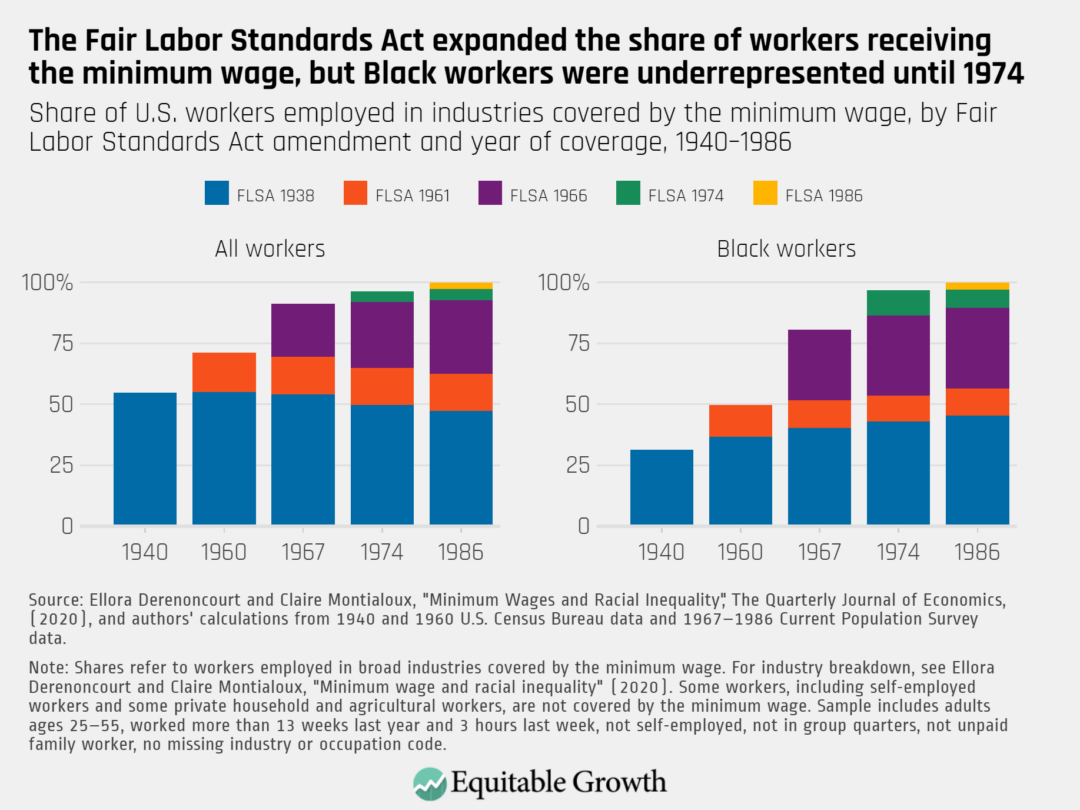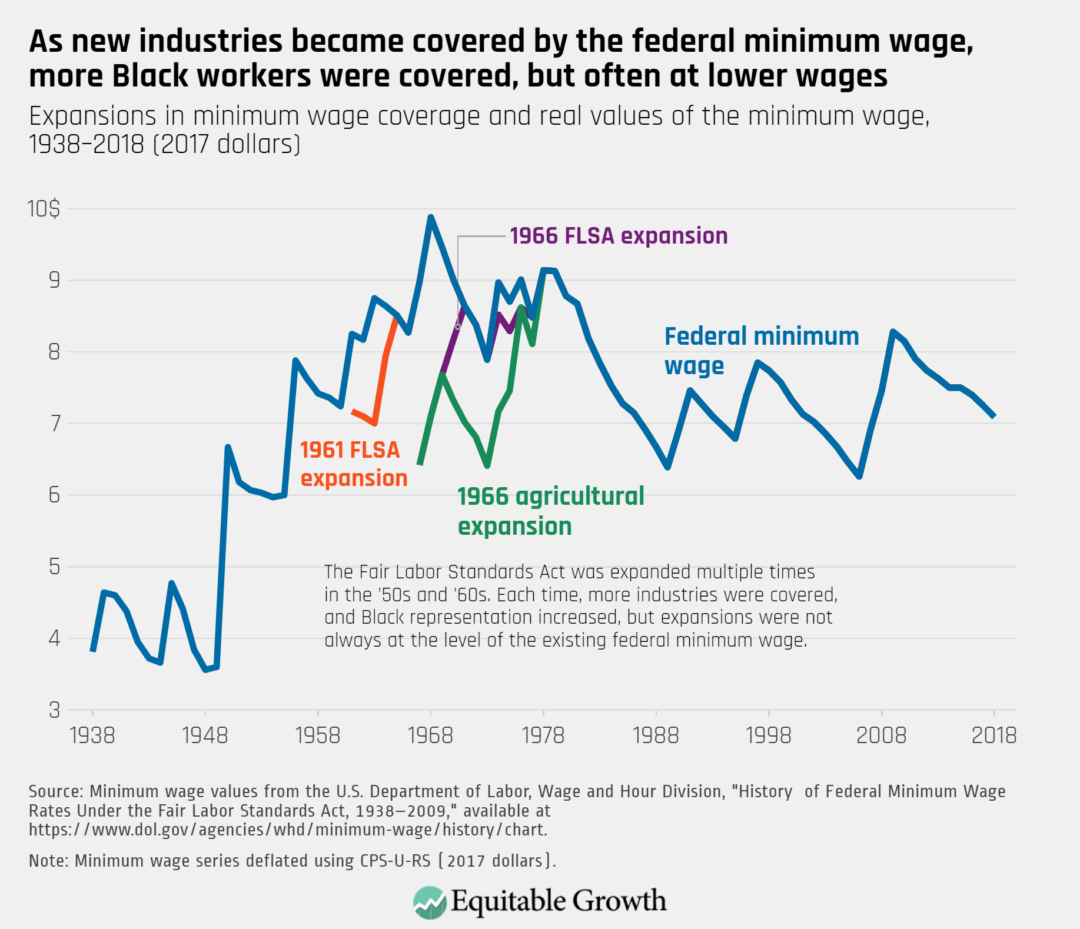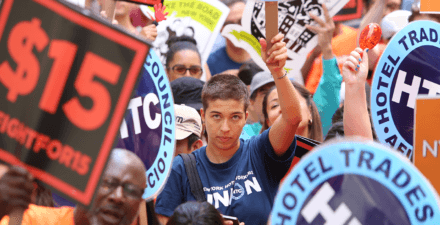Why minimum wages are a critical tool for achieving racial justice in the U.S. labor market

Overview
The minimum wage is one of the primary tools for raising the wages of low-income workers. This was the case at its inception in some states in the early 20th century, as a key federal component of the New Deal reforms during the Great Depression, and today, amid the coronavirus recession. Importantly, though, reforms in the 1960s turned the minimum wage into a critical tool for decreasing the wage divides between Black and White workers because Black Americans were overrepresented among low-wage workers who were not initially covered by the federal minimum wage. Yet those reforms six decades ago are now increasingly unable to address racial income inequality without keeping pace with inflation and economic growth.
Indeed, the coronavirus recession demonstrates how persistent disparities in economic security by race and ethnicity are exacerbated in a crisis. Black and Latinx households today are more likely to report a loss in income and difficulty paying expenses. And the tenuous partial recovery of the U.S. labor market since the start of the current recession now appears to have stalled, leaving Black and Latinx workers with significantly elevated unemployment in the double digits.
Research from previous economic downturns highlights how these racial income disparities will not be alleviated by market forces in the eventual post-pandemic recovery. Centering racial justice in economic policy is critical to ensuring broadly shared growth in the future.
This issue brief shows how minimum wages were and remain an important tool for racial justice. We first examine the role of minimum wages today in perpetuating the current racial income divide. We then review who was covered historically by minimum wages, and how the changing real value of minimum wages over time and across geographic divides reflect continued structural racism. We then close with an analysis of what it would mean for economic security of Black and Latinx families to increase the federal minimum wage closer to a living wage.
Low minimum wages and the racial wage divide
The racial wage divide is one of the most persistent features of the U.S. labor market. Yet a greater proportion of specific wage gaps between Black men and White men and Black women and White men are “unexplained” by the so-called human capital model or are interpreted by economists as the result of overt discrimination, compared to the gender wage gap between all men and all women workers, which is explained to a greater extent by differences in occupational segregation.
What is clear is that the wage gap between Black and White workers persists across the wage distribution and is larger at the top of end of the wage distribution, where Black workers are excluded from high-wage jobs. One of the primary reasons this racial wage divide is less severe at lower wage levels is because of the minimum wage. By design, minimum wages boost the pay of workers who are among the lowest-paid in the U.S. labor market. And Black workers have the highest share of those who are paid the minimum wage among all major racial and ethnic groups in the United States.
Increasing the minimum wage to $15 an hour, for example, would increase the earnings of 38.1 percent of Black workers, compared to 23.2 percent of White workers. This calculation is based on a combination of workers in states whose minimum wage is determined by the current federal minimum wage of $7.25 per hour, workers in states with a state minimum wage below the federal minimum, and workers in all other states who are currently earning less than $15 per hour.
Black and Latinx workers also are more likely to experience wage theft, where they are paid less than the statutory minimum wage by their employers, because of the ineffective enforcement of minimum wage standards. According to new research by Rutgers University labor market researchers Janice Fine, Jenn Round, Daniel Galvin, and Hana Shepherd, Black workers are 50 percent more likely than White workers to experience a minimum wage violation, and Latinx workers are 84 percent more likely to experience this serious labor market problem. Black women who are not U.S. citizens are 3.7 times—370 percent—more likely to experience a minimum wage violation, compared to White male U.S. citizens.
The upshot is that the level of minimum wages, who they apply to, and how well they are enforced all play a role in offsetting racial wage inequality and working toward racial economic justice.
How historical exclusions and expansions to minimum wages influenced racial wage inequality
The minimum wage played an important role in driving more equitable U.S. labor market outcomes since it was first introduced in individual states beginning in 1912 and federally as part of the Fair Labor Standards Act of 1938. When the Fair Labor Standards Act first came into effect, the federal minimum wage was mandated in sectors such as transportation, finance, manufacturing, and wholesale trade, covering about 54 percent of the U.S. workforce. Due to opposition from Congress, however, the initial legislation excluded sectors in which Black workers represented a large share of the workforce—even though President Franklin D. Roosevelt intended it cover the entire U.S. economy.
In particular, both state-level minimum wages from 1912 to 1923 and the Fair Labor Standards Act of 1938 played into highly racialized and gendered conceptions of work that excluded Black workers and in particular Black women as “Neither Mothers Nor Breadwinners.” Early state-level minimum wages that were passed between 1912 and 1923 during in the Progressive Era both adopted the rhetoric of protecting vulnerable women while also excluding farming and domestic services industries where Black women were overrepresented. Then, in 1923, the Supreme Court case Adkins v. Children’s Hospital ruled that minimum wage laws covering women workers violated their freedom of contract.
With the passage of the Fair Labor Standards Act in 1938 as part of the New Deal, the focus was to promote and maintain the breadwinner status of male heads of household. Yet congressional compromises over the federal minimum wage excluded male and female workers in industries in the South that were disproportionately Black. Thus, despite Progressive Era and New Deal legislation intended to improve the conditions of work, Black workers, and Black women in particular, were largely left out.
Over the following decades, the Fair Labor Standards Act was modified to cover a larger share of the U.S. workforce. The 1961 amendment introduced the minimum wage to workers in some retail trade and construction establishments, and the 1966 Fair Labor Standards Act—the largest expansion of the minimum wage—provided coverage to workers in agriculture, nursing homes, laundries, hotels, restaurants, schools, and hospitals. The year the new legislation came into effect, approximately 8 million workers, or a fifth of all U.S. prime-aged workers, were employed in the newly covered sectors. It was not until this expansion that the majority of Black workers had access to the federal minimum wage.
In 1966, the Fair Labor Standards Act also was amended to introduce a $1 wage floor to sectors such as agriculture, schools, nursing homes, and restaurants. As the legislation came into effect in 1967, earnings growth in the newly covered sectors jumped, relative to earnings in the sectors that had been covered by the initial Fair Labor Standards Act of 1938. The positive effect of the minimum wage expansion was almost twice as large for Black workers than for White workers, according to new research by two of the authors of this issue brief, Ellora Derenoncourt and Claire Montialoux. This is because the newly covered sectors employed about a fifth of the U.S. labor force, or almost a third of all Black workers. Even more importantly, the legislation had an especially large effect on workers whose previous wages were below $1, among whom Black workers were also overrepresented. (See Figure 1.)
Figure 1

Derenoncourt and Montialoux also document the effect of the 1966 Fair Labor Standards Act on employment. They find that the minimum wage expansion did not lead to large disemployment effects for either Black or White workers. As a result, the 1967 minimum wage expansion also led to a decline in the racial income divide. Overall, the introduction of a $1 minimum wage floor explains more than 20 percent of the fall in both the racial earnings and income divides experienced between 1965 and 1980.
Previous studies had alternatively credited improved educational outcomes for the Black population (in terms of both number of years of school and quality of education) and federal anti-discrimination policies for the decline in the racial earnings gap during the civil rights era and immediately afterward. But it’s clear now that the 1967 expansion of the minimum wage to previously uncovered sectors of the U.S. economy also made a significant contribution.
A higher federal minimum wage would help regional wage dispersion and reduce the racial wage gap
In the United States, earnings across states and territories range from the highest median wage of $35.74 in the District of Columbia to $15 in Mississippi to the lowest median wage of $10.13 in Puerto Rico. This is due to a wide variety of factors, including differences city and state minimum wage statutes above the federal minimum wage and industrial composition between states that influence median earnings in those states.
Twenty-nine states boast minimum wages today that are higher than the current federal minimum wage of $7.25 per hour, and 48 localities have adopted minimum wages higher than their state minimum wage or the federal minimum wage. Wages are also lower in states that have so called right-to-work laws and have lower union density. These states also tend to have more resistance to minimum wage increases. A higher federal minimum wage would help establish a floor across the nation, rather than institutionalize regional wage dispersion.
Variations in wages across states and regions immediately lead to arguments over whether a higher federal minimum wage will actually harm workers in states with lower median wages, since the increase to the minimum wage would be a more substantial relative increase, compared to states that have independently raised their minimum wages above the federal floor. But as Derenoncourt and Montialoux’s research on the history of the federal minimum wage increase in 1967 shows, a significant national wage increase may be sustainable since the expansion of minimum wages to previously uncovered industries was, in effect, an infinite increase above the prior minimum of $0.
The ability to significantly increase minimum wages without roiling U.S. regional labor markets is further supported by additional research. This research finds that increases of nearly 40 percent in the federal minimum wage, which would be similar in magnitude to the increases in the minimum wage that Seattle enacted between 2013 and 2016, would likely not have had a disemployment effect at the time on a national scale while also alleviating the worst earnings losses experienced during the Great Recession of 2007–2009 and afterward.
This finding points to the conclusion that a higher minimum wage would be an effective tool for mitigating the racially disparate negative economic consequences of the coronavirus recession, too.
A higher federal minimum wage would reduce poverty rates for Black and Latinx families
Black and Latinx workers are significantly more likely to be paid poverty-level wages than White workers. This is why minimum wage levels are an especially important tool for raising the earnings and decreasing the economic precarity of the working poor. And it is no surprise that states with the highest poverty rates are also among those that have not independently increased their minimum wage above the federal floor.
Amid the coronavirus recession, millions of families fell into poverty after the financial relief provided by the Coronavirus Aid, Relief, and Economic Security, or CARES, Act largely diminished with the expiration of the $600 plus-up in unemployment benefits at the end of July. These patterns will persist unless robust and inclusive economic policies, including an increased federal minimum wage, are part of the efforts to rebuild the economy centering racial justice.
Furthermore, the real value of the federal minimum wage declined beginning in the late 1970s to the late 1980s, just as the convergence of the racial wage gap began to stutter. Currently, the minimum wage has not been increased since 2009, when it rose from $6.55 per hour to its current level of $7.25 per hour. In fact, the highest value of the minimum wage was at the time of the 1967 expansion. At that time, the federal minimum wage was nearly $10 per hour in 2017 dollars. (See Figure 2.)
Figure 2

The U.S. economy, of course, is much larger and more productive than it was in the 1960s, yet low-wage workers are not sharing in those gains. Had the 1968 minimum wage kept up with inflation and productivity growth, it would actually be $24 per hour today. Raising the minimum wage would turn back the declining real value of the minimum wage, reduce racial wage gaps as long as Black and Latinx workers are more likely to be low-wage workers, and reduce the higher likelihood of poverty for Black and Latinx families.
Conclusion
This past August was the 57th anniversary of the historic March on Washington for Jobs and Freedom. Raising the federal minimum wage would help achieve the vision of racial justice outlined in the march: One of the 10 listed demands in the organizers’ platform was extending the federal minimum wage to previously uncovered workers, which was accomplished in the years following with the extensions of the Fair Labor Standards Act. Civil rights leaders more than half a century ago knew that the minimum wage was a critical tool for addressing racial wage gaps and higher poverty levels by race. The coronavirus recession now brings into stark relief how structural racism still influences economic outcomes of workers and families, elevating calls once again to raise the minimum wage as an important tool for racial justice that will foster broadly shared economic growth in the post-pandemic recovery.






